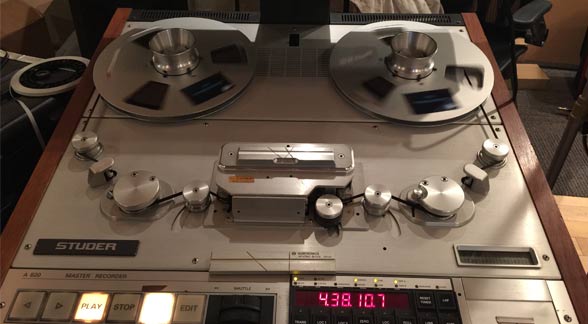An Analog Weekend
I’m sitting here in my main studio control room watching reels turn on both my Nagra IV-S and the Studer A820 1/4″ 2-track machine I rented yesterday. I had hoped to be further along at this point on Saturday but it took much longer to get everything wired up and aligned than I had planned. I actually left the building last evening without having made any transfers…much to my disappointment.
When I was asked about aligning an analog tape machine by the gentleman that is Tim Jordan rentals, I told him it had been a few years but that I had done that task hundreds of times on a variety of tape decks. What I didn’t tell him was that I had never aligned a Studer. I’m familiar with Ampex, 3M, Sony, Stephens, and Otari machines but the one occasion that I remember recording with a Studer, the machine was all set up ahead of time (it was at Lucas Ranch and they took care of pretty much everything).
So it was operator error or more like complete ignorance when I started looking for the alignment cards on the Studer. I know some of you are probably going to laugh at me but I couldn’t for the life of me figure out where the adjustments are supposed to me made. I searched the Internet and discovered that the electronics are buried down in the lower section of the machine, so I tried opening that door. It wouldn’t budge without the right hex driver. I stopped by the local hardware store and purchased a metric hex set and was all set to come back first thing in the morning and open the stubborn door. That was until Rodney called me back last night and explained how this machine works.
He told me about the LCD display and the menuing system located under the small aluminum door on the right front of the deck. From there it was easy…in fact, very easy to follow his instructions. Rodney had done the playback alignment at his place but was unable to take care of the record alignment because he didn’t know what type of tape I was going to be using. I figured “no problem”, I have a tweeker and a console that can output the required tones…what could go wrong?
Well how about a problem that the very experienced gentleman couldn’t understand? I plugged the output a left and right balanced output from my console into the left and right balanced inputs of the Studer. So far so good. The tones were on the “B” stereo bus so it seemed reasonable to return the output of the Studer to the “B” stereo returns. This is a very typical setup, which allows an engineer to compare the input to the output quickly and easily. An analog deck can record and playback at the same time. It’s called “confidence” recording and guarantees that you’re actually making a recording AND what it sounds like. If there’s any overloads or other problems, you know about it right away.
The problem that I couldn’t solve was why the levels on my console showed zero on the VU meters and minus 20 on the inputs of the Studer. They should match and I wasn’t even close. And I couldn’t adjust the calibrated level to get close. We must have spent 30 minutes on the phone trying to figure out the problem. I connected the tones to at least three other devices in the studio…including the Dolby 363…and everything worked as expected. The Studer was acting as if there was a 20 dB pad in the signal path.
Finally, Rodney said, “take the outputs of the Studer and connect them to the inputs of the Dolby unit”. I had a short XLR cable nearby, unplugged the left channel output and connected the new cable from the left output to the left input of the Dolby 363. Presto! The left on the Studer shot up to zero! I was astonished…and so was Rodney. Something about my patch bay or the analog to MADI (a multichannel converter) was loading down the Studer. Who knew?
With the problem solved, I did a complete record alignment and then proceeded with “making copies”. I’ll be here a while…I’ve got 5 sets of the Christian Jacob “Beautiful Jazz” finished and 4 more to go. And then it’s on to the LA4 “Just Friends” copies. It’s not all celebrities and hit making in the world of audio engineering. This is the reality of “making copies”.
My wife did promise to come by with some food and Charlie…so at least I’ll have some company.


Dang, each one in real time. You’d be better off having some vinyl pressings done. 😉
I guess Mark is doing this ‘for the fun’.